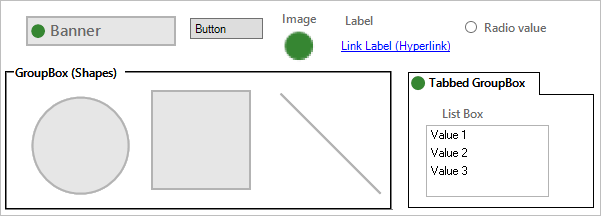Standard Form Controls
A Standard Control is a Form Control that enhances Form design and data entry. CSM provides the following Standard Controls:
- Banner: Displays a title (text) and image (ex: Company name and logo, title and icon, permanent contact information, etc.).
- Button: Executes a single Action when clicked (ex: Open a Rich Text zoom window, launch a Visualization, view related Knowledge Articles, move to the next Form in a multi-Form process, etc.).
- Group Box/Tabbed Group Box: Organizes other Controls in containers to enhance a Form's appearance and usability.
- Image: Displays a custom image (ex: Company logo, Team icon, personal photo, etc.).
- Label: Textually identifies or enhances other Form elements. Often, a label is tied to and identifies a Field Control.
- Link Label: Executes a single Action when clicked (ex: Move a record through a workflow, send a Customer e-mail, submit resolution details to the Knowledge Base, etc.).
- List Box: Displays multiple values from which a User can select (ex: Call sources, list of Services, distribution list, etc.).
- Radio Button: Presents a list of choices and stores a value for the selection (ex: Show all tabs or just related tabs in a Form Arrangement, toggle between Embedded Forms, etc.).
- Shapes (Ellipses, Lines, and Rectangles): Organizes other Controls to enhance a Form's appearance and usability.
The following figure shows the Standard Form Controls on a Form.

Good to know:
- By default, a Standard Control's font, colors (background, foreground, and border), border style, and background style properties come from the defined Form Theme; however you can define your own properties, if needed.
- Image Controls do not support text, background, foreground, or border colors; therefore no colors, styles, or fonts can be applied.
- To include an ampersand character (&) in a Label or Link Label Control, enter two ampersands (&&). One ampersand is used to designate a keyboard accelerator, so entering a double ampersand escapes the accelerator and ensures that a single ampersand is displayed.
- After a Standard Form Control is added to a Form, you can define how the Control looks and behaves on the Form (ex: Size, alignment, visibility, etc.).